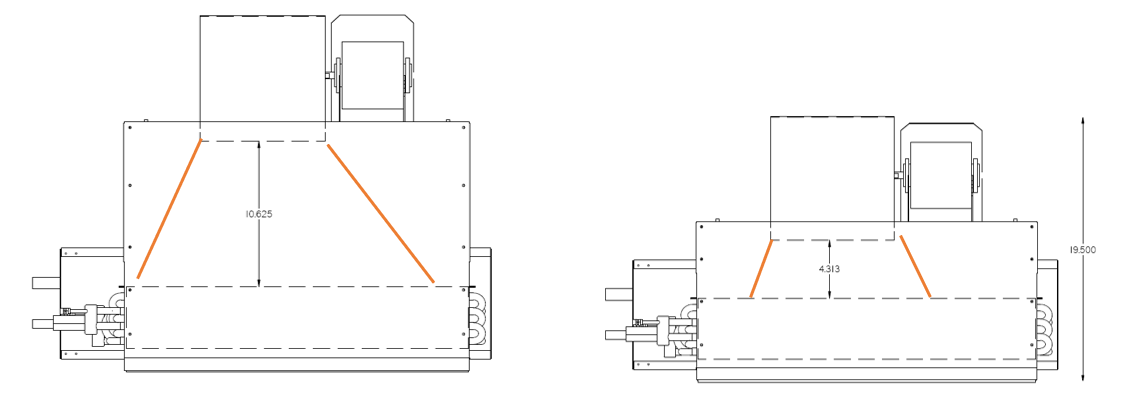
Our previous article highlights the variables to consider when choosing a Horizontal Fan Coil design for a project. The highest volume unit type in the industry is the in-room horizontal fan coil unit. The units are ideal for hotel rooms, condominiums, and small offices. They are typically installed above a ceiling and supply directly to the room they serve. The air returns through a grille in the ceiling, either directly into the unit or through the plenum. This article will discuss how the units work, the options available for each unit, and the design considerations when choosing an in-room horizontal fan coil unit.
5 Design Variables
The previous article highlighted the five variables to consider when selecting a horizontal fan coil unit. The variables are capacity, static pressure, available ceiling space, sound sensitivity, and outside air capabilities. The in-room fan coil units perform per the information below:
Capacity Requirements
- 300-1,500 CFM
- 2/3-3.5 Tons Cooling
- 9-73 MBH Hot Water Heating
- 1-10 KW Electric Heating
External Static Pressure
- Low, up to 0.5" w.g.
- Motors are pressure dependent
Available Ceiling Space
- Concealed Units, 10"
- Exposed Units, 12"
Sound Sensitivity
- Medium
- Most are unducted, causing them to be slightly louder than other options
Outside Air Capabilities
- Low
- Limited to 4 rows of cooling coil, limits the fan coils ability to handle the latent loads associated with outside air
In summary, these units are ideal for small spaces with limited ceiling space in applications that do not have to handle high amounts of static pressure or latent load. The units are perfect for where they primarily serve hotels, condominiums, and small office spaces.
Configurations
These units are available in four configurations: free return, plenum, telescoping, and exposed.
Free Return
The lowest cost assembly is the free return design. The fans blower and motor are mounted to the side of the cabinet and remain open to the return air source.
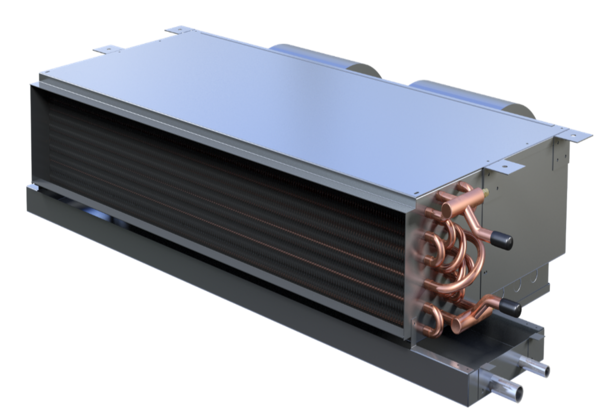
Plenum
The plenum configuration extends the cabinet around the fan blower and motors. The plenum can be open on the bottom or back of the unit depending on the application. Adding the plenum makes the unit easier to duct the return, it also reduces the radiated sound from the unit by providing a layer of sheet metal and insulation around the fan(s).
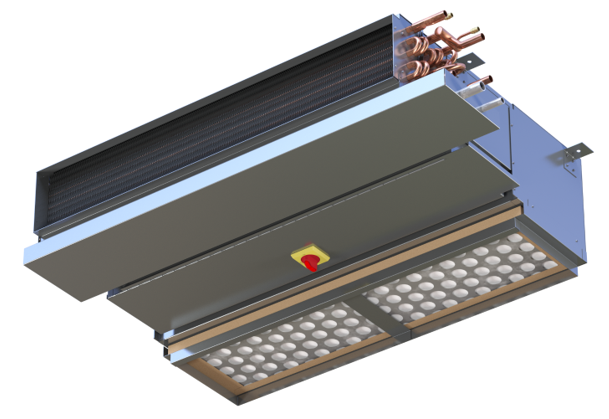
Telescoping
Many of these units are installed directly above an access panel with a filter grille. This version provides a telescoping extension that connects the unit with the filter grille below. The extension enables a direct path to the unit for the return air.
Exposed
This unit has an enclosure that surrounds the entire unit. The design allows the unit to be exposed in the room.
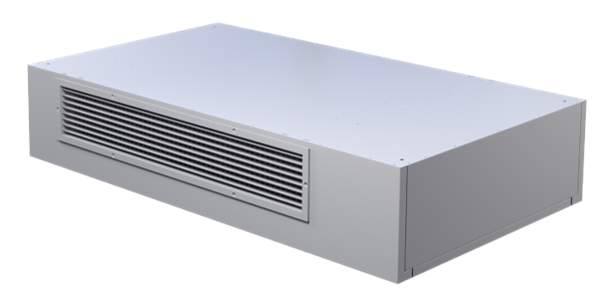
Unit Design
The in-room horizontal fan coil units, like the Nailor Engineered Comfort 40H, fit a lot of functionality in a small package. The components include a cabinet, fan/blower, coils, and accessories.
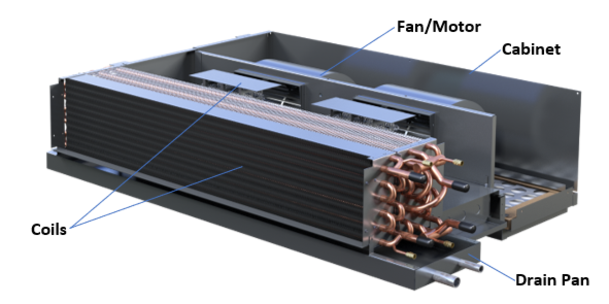
Cabinet
The sheet metal cabinet provides the framework for all the components to be mounted and operate together. The cabinet includes a chamber for the coil, the electrical box, and the insulated condensate drain pan.
The Nailor 40H cabinet design aids serviceability by having the electrical box is on the bottom of the unit.
Fan/Blower
The in-room fan coils are blow-through in design. The fan is mounted on the back of the unit and they direct the airflow through the coils. The fan and blower wheel combination is optimized for energy efficiency. There are several motor types available:
- 3-Speed PSC
- 3-Speed ECM
- Modulating ECM
Each of these has a trade-off between cost and energy efficiency. The PSC is lower cost and lower efficiency, while the modulating ECM is higher cost and higher efficiency. With the small size of the fans and motors, each is pressure dependent. Pressure-independent motors are not available in this size of fan coil.
Coils
Three types of coils are available for these units, chilled water, hot water, and electric heating. The chilled water cooling coil can be up to 4 rows of cooling. A hot water heating coil, usually located in the reheat position in front of the cooling coil, can be up to 2 rows for a total of 6 rows. If electric heat is preferred, the electric coil is in front of the fans inside the cabinet.
Accessories
Many accessories are available with an in-room fan coil unit:
- Valve Packages
- Control Valve
- Auto Flow Control
- Shut-off valves
- Flexible Hoses
- Accessories
- Y
- Unions
- PT Ports
- Thermostats
- Factory Mounted Controls
- Condensate Pumps
- Outside Air Inlets
- For pretreated air
Controls
The traditional method of controlling these fan coils is like what you experience in your home DX Split system. The unit will cycle on or off depending on the thermostat setting. A hydronic fan coil system requires the control valve to open and the fan to operate. More advanced systems utilize a modulating fan and valves. The thermostat controls the fan speed to regulate the comfort in the space, while the modulating control valve ensures a constant leaving air temperature from the coil.
Nailor Differentiators
Most competitive products on the market position the fan directly against the coil. The result is a blast area at the coil, in some cases the air velocity through the coil can exceed 500 ft/min, at this velocity condensate on the coil can be blown into the room. Nailor has chosen to lengthen the cabinet to get a better distribution across the entire face of the coil. This reduces the chance of blowing condensate as well as increases the heat transfer to the air in the space, resulting in a more efficient unit. The lower velocities through the coil also result in a quieter operation.
